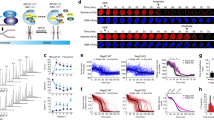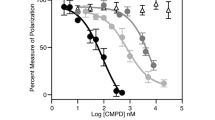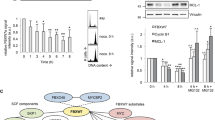Abstract
Nuclear foci containing the promyelocytic leukemia protein (PML bodies), which occur in most cells, play a role in tumor suppression. Here, we demonstrate that CHFR, a mitotic checkpoint protein frequently inactivated in human cancers, is a dynamic component of PML bodies. Intermolecular fluorescence resonance energy transfer analysis identified a distinct fraction of CHFR that interacts with PML in living cells. This interaction modulates the nuclear distribution and mobility of CHFR. A trans-dominant mutant of CHFR that inhibits checkpoint function also prevents colocalization and interaction with PML. Conversely, the distribution and mobility of CHFR are perturbed in PML−/− cells, accompanied by aberrations in mitotic entry and the response to spindle depolymerization. Thus, PML bodies control the distribution, dynamics and function of CHFR. Our findings implicate the interaction between these tumor suppressors in a checkpoint response to microtubule poisons, an important class of anticancer drugs.
This is a preview of subscription content, access via your institution
Access options
Subscribe to this journal
Receive 12 print issues and online access
$189.00 per year
only $15.75 per issue
Buy this article
- Purchase on Springer Link
- Instant access to full article PDF
Prices may be subject to local taxes which are calculated during checkout







Similar content being viewed by others
References
Melnick, A. & Licht, J.D. Deconstructing a disease: RARα, its fusion partners, and their roles in the pathogenesis of acute promyelocytic leukemia. Blood 93, 3167–3215 (1999)
Takahashi, Y., Lallemand-Breitenbach, V., Zhu. J. & de Thé, H. PML nuclear bodies and apoptosis. Oncogene 23, 2819–2824 (2004).
Jensen, K., Shiels, C. & Freemont, P.S. PML protein isoforms and the RBCC/TRIM motif. Oncogene 20, 7223–7233 (2001).
Wang, Z.G. et al. Role of PML in cell growth and the retinoic acid pathway. Science 279, 1547–1551 (1998).
Gurrieri, C. et al. Loss of the tumor suppressor PML in human cancers of multiple histologic origins. J. Natl. Cancer Inst. 96, 269–279 (2004).
Zhong, S., Muller, S., Freemont, P.S., Dejean, A. & Pandolfi, P.P. Role of SUMO-1-modified PML in nuclear body formation. Blood 95, 2748–2753 (2000).
Salomoni, P. & Pandolfi, P.P. The role of PML in tumor suppression. Cell 108, 165–170 (2002).
Zhong, S., Salomoni, P. & Pandolfi P.P. The transcriptional role of PML and the nuclear body. Nat. Cell Biol. 2, E85–E90 (2000).
Scolnick, D.M. & Halazonetis, T.D. Chfr defines a mitotic stress checkpoint that delays entry into metaphase. Nature 406, 430–435 (2000).
Chaturvedi, P. et al. Chfr regulates a mitotic stress pathway through its RING-finger domain with ubiquitin ligase activity. Cancer Res. 62, 1797–1801 (2002).
Spector, D.L. Nuclear domains. J. Cell Sci. 114, 2891–2893 (2001).
Muller, S., Matunis, M.J. & Dejean, A. Conjugation with the ubiquitin-related modifier SUMO-1 regulates the partitioning of PML within the nucleus. EMBO J. 17, 61–70 (1998).
Jares-Erijman, E.A. & Jovin, T.M. FRET imaging. Nat. Biotechnol. 21, 1387–1395 (2003).
Rieder, C.L. & Cole, R. Microtubule disassembly delays the G2-M transition in vertebrates. Curr. Biol. 10, 1067–1070 (2000).
Bothos, J., Summers, M.K., Venere, M., Scolnick, D.M. & Halazonetis, T.D. The Chfr mitotic checkpoint protein functions with Ubc13-Mms2 to form Lys63-linked polyubiquitin chains. Oncogene 22, 7101–7107 (2003).
Chang, K.S., Fan, Y.H., Andreeff, M., Liu, J. & Mu, Z.M. The PML gene encodes a phosphoprotein associated with the nuclear matrix. Blood 85, 3646–3653 (1995).
Kang, D., Chen, J., Wong, J. & Fang, G. The checkpoint protein Chfr is a ligase that ubiquitinates Plk1 and inhibits Cdc2 at the G2 to M transition. J. Cell Biol. 156, 249–259 (2002).
Aravind, L., Iyer, L.M. & Koonin, E.V. Scores of RINGS but no PHDs in ubiquitin signaling. Cell Cycle 2, 123–126 (2003).
Boisvert, F-M., Hendzel, M. & Bazlett-Jones, D.P. Promyelocytic leukemia (PML) nuclear bodies are protein structures that do not accumulate RNA. J. Cell Biol. 148, 283–292 (2000).
Corn, P.G. et al. Frequent hypermethylation of the 5′ CpG island of the mitotic stress checkpoint gene Chfr in colorectal and non-small cell lung cancer. Carcinogenesis, 24, 47–51 (2003).
Toyota, M. et al. Epigenetic inactivation of CHFR in human tumors. Proc. Natl. Acad. Sci. USA 100, 7818–7823 (2003).
Mariatos, G. et al. Inactivating mutations targeting the chfr mitotic checkpoint gene in human lung cancer. Cancer Res. 63, 7185–7189 (2003).
Satoh, A. et al. Epigenetic inactivation of CHFR and sensitivity to microtubule inhibitors in gastric cancer. Cancer Res. 63, 8606–8613 (2003).
Sakaguchi, D.S., Coffman, C.R., Gallenson, N. & Harris, W.A. A glial cell line promotes the outgrowth of neuritis from embryonic Xenopus retina. Acta Biol. Hung. 39, 201–209 (1988).
Manders, E.M., Stap, J., Brakenhoff, G., van Driel, R. & Aten, J.A. Dynamics of three-dimensional replication patterns during the S-phase, analysed by double labelling of DNA and confocal microscopy. J. Cell Sci. 103, 857–862 (1992).
Bastiaens, P.I., Majoul, I.V., Verveer, P.J., Soling, H.D. & Jovin, T.M. Imaging the intracellular trafficking and state of the AB5 quaternary structure of cholera toxin. EMBO J. 15, 4246–4253 (1996).
Ellenberg, J. et al. Nuclear membrane dynamics and reassembly in living cells: targeting of an inner nuclear membrane protein in interphase and mitosis. J. Cell Biol. 138, 1193–1206 (1997).
Yu, D.S. et al. Dynamic control of Rad51 recombinase by self-association and interaction with BRCA2. Mol. Cell 12, 1029–1041 (2003).
Earnshaw, W.C. Mitotic chromosome structure. Bioessays 9, 147–150 (1988).
Acknowledgements
M. Daniels generously assisted us with XR1 cell culture and preparation of X. laevis extracts, and T. Mills with microinjection. T. Rich (Department of Pathology, University of Cambridge) and P.-P. Pandolfi (Memorial Sloan-Kettering Institute, New York) supplied the PML-YFP construct, and PML−/− and control MEFs, respectively, and provided constructive comments on this paper, as did L. Ko-Ferrigno. M.J.D. was supported by an Astra-Zeneca studentship, through the MB/PhD program at the University of Cambridge, and by the UK Medical Research Council. A.M. was the receipient of a Herchel Smith Harvard scholarship. Work in A.R.V.'s laboratory is supported by the Medical Research Council and Cancer Research UK.
Author information
Authors and Affiliations
Corresponding author
Ethics declarations
Competing interests
The authors declare no competing financial interests.
Supplementary information
Supplementary Fig. 1
Negative control experiments for FRET interaction between CFP-CHFR and PML-YFP. (PDF 1505 kb)
Supplementary Fig. 2
GFP does not coprecipitate with PML. (PDF 635 kb)
Supplementary Video 1
Two-dimensional rendering of serial z-sections. To exclude the possibility that the small CHFR-containing foci shown in Figure 4 are migrating in/out of the plane-of-focus, we acquired images of an entire YFP-CHFR-expressing cell nucleus with overlapping z-sections over time. We have then rendered the three-dimensional image at each time point into two dimensions as a maximum intensity projection. When played in sequence, this series of images reveals the movement of all YFP-CHFR-containing foci within a single cell nucleus. The Supplementary Video file shows this experiment. It suggests that most of the CHFR-containing foci are not simply migrating in/out of the plane of focus, but are indeed interacting with large foci as discussed in the main text. (AVI 35101 kb)
Rights and permissions
About this article
Cite this article
Daniels, M., Marson, A. & Venkitaraman, A. PML bodies control the nuclear dynamics and function of the CHFR mitotic checkpoint protein. Nat Struct Mol Biol 11, 1114–1121 (2004). https://doi.org/10.1038/nsmb837
Received:
Accepted:
Published:
Issue Date:
DOI: https://doi.org/10.1038/nsmb837
This article is cited by
-
Spatiotemporal regulation of the Dma1-mediated mitotic checkpoint coordinates mitosis with cytokinesis
Current Genetics (2019)
-
Tumor Necrosis Factor Receptor Associated Factors (TRAFs) 2 and 3 Form a Transcriptional Complex with Phosho-RNA Polymerase II and p65 in CD40 Ligand Activated Neuro2a Cells
Molecular Neurobiology (2017)
-
Emerging evidence for CHFR as a cancer biomarker: from tumor biology to precision medicine
Cancer and Metastasis Reviews (2013)
-
Primary cilia and aberrant cell signaling in epithelial ovarian cancer
Cilia (2012)
-
Expression level of the mitotic checkpoint protein and G2–M cell cycle regulators and prognosis in gastrointestinal stromal tumors in the stomach
Virchows Archiv (2012)



